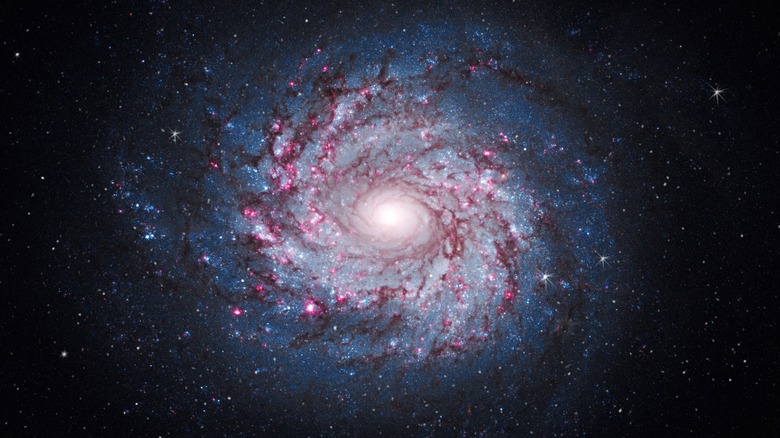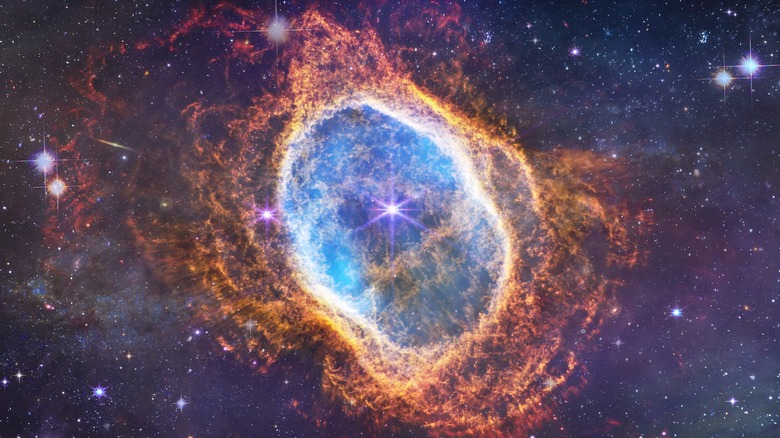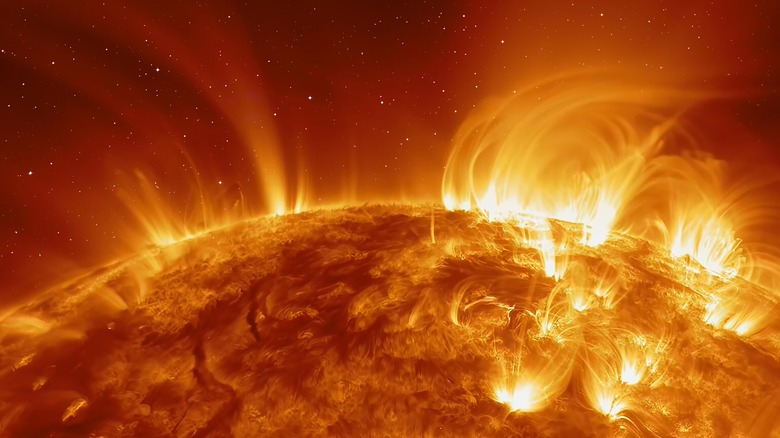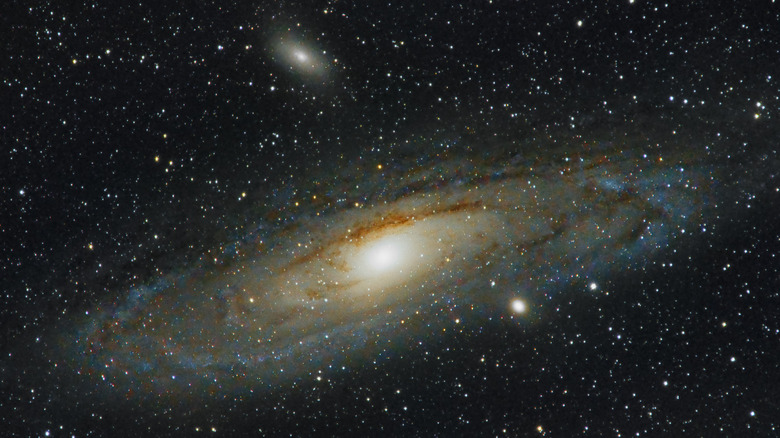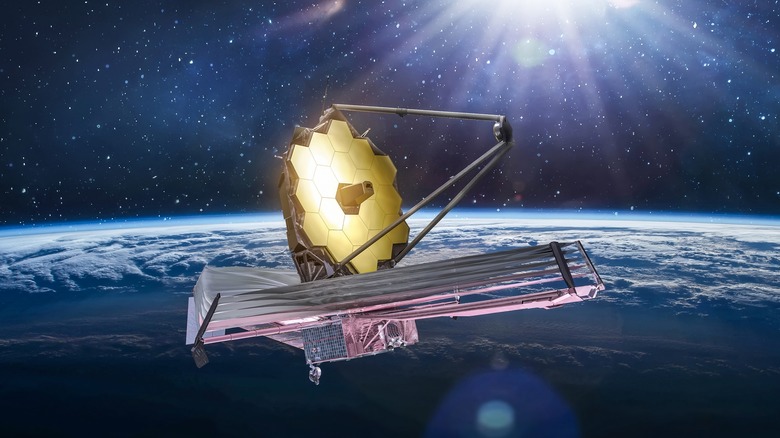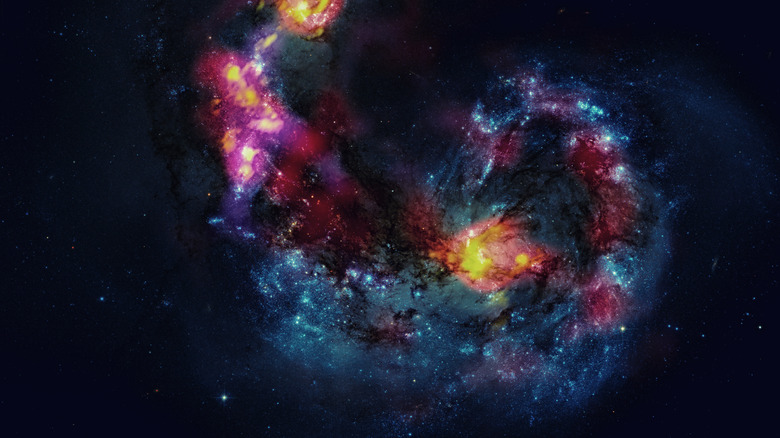The Appearance Of One Messy Galaxy Revealed Its Distant Past
For most Americans, the gold standard of space telescopes is the Hubble, a massive scientific apparatus that was first launched into space in 1990, and later serviced in 1993, 1997, 1999, 2002 and 2009 to keep the telescope going (via Britannica). Orbiting around our planet, the Hubble is able to see many different stars and galaxies that aren't visible from within the Earth's atmosphere. Over its more than 30 years in service, the Hubble has taken photos of many stunning features of space, including two previously unknown moons of Pluto, and has helped scientists uncover equations like the rate at which the universe expands.
But the Hubble telescope is no longer the big kid on the block. Though the Hubble will continue to photograph the universe, there's a new name in the game: the James Webb Space Telescope. Created by NASA alongside the European Space Agency and Canada (also via Britannica), the James Webb telescope has infrared cameras which can see details of the universe that are hidden to the Hubble, according to Live Science. It was first launched at the end of 2021. Now, it's revealed a host of new discoveries, per the Hindustan Times, including new details about the Cartwheel Galaxy that reveal a dark moment from its history.
History of the Cartwheel Galaxy
The Cartwheel Galaxy was first studied from various observatories in Australia, according to The New York Times. The galaxy is 500 million light years away from Earth, according to Live Science. It's long fascinated astronomers because of its unique form. Unlike a standard elliptical galaxy, the Cartwheel Galaxy has a particular shape which has suggested to scientists that there might have been a significant collision in the galaxy's history. Called a ring galaxy, according to NASA, the galaxy has two distinct separate sections: an inner and outer ring. At the middle of the galaxy, which can be found in the Sculptor constellation, is a black hole.
However, despite high interest, scientists have not been able to get a good photo of the galaxy until recently. In the 1990s, the Hubble telescope snapped a picture, but because of the high levels of dust in the galaxy, there wasn't really a precise image, per NASA. That was, at least, until the James Webb Telescope was launched. This telescope, which reaches nearly 70 by 30 feet, can take far more advanced photos, per the Webb Space Telescope.
How galaxies are formed
Perhaps everyone's heard of galaxies, but might not know just what they are. "Galaxies are collections of stars, dust, and dark matter held together by gravity," NASA reports. There are a couple different ideas about how galaxies might have come about, according to StarDate. The first theory is that, in the early days of the universe, dust and gases clumped together due to gravity and formed the first stars. This was due to a density issue, according to NASA's Hubblesite. Areas which contained a lot of gas and dust were denser and so led to slower overall expansion, which, alongside gravity, led to the formation of the first stars. Although these stars burned out, the accumulation of material was already high enough to become rotating disks — galaxies — in which new stars began to pop up. An alternate theory of galaxy formation says that, instead of dust and gas, it was pre-existing "lumps" of matter which came together to form galaxies, according to StarDate.
Most galaxies are still growing, in part through collision and aggregation into bigger galaxies. The Milky Way and Andromeda galaxies, for example, which are each around 100,000 light years across, are set to collide in 4 billion years, creating one massive galaxy, per Hubblesite.
Types of galaxies
There are three main types of galaxies: elliptical galaxies, spiral galaxies, and irregular galaxies (per Hubblesite). Elliptical galaxies have relatively older stars, and are less active galaxies that aren't necessarily still growing. These galaxies — which include the Cygnus A galaxy and M87 galaxy, according to Space.com – are usually relatively small, only a few thousand light years across. Those elliptical galaxies which are larger were probably the result of smaller galaxies combining, per StarDate.
Spiral galaxies are more common, and include both the Milky Way galaxy and the Andromeda galaxy, our nearest neighbor. These come in the shape of relatively flat disks with the appearance of a light spiral throughout them. They are often still growing and changing and new stars are being produced within most spiral galaxies, reports Hubblesite.
Finally, irregular galaxies are relatively uncommon. As the name suggests, they don't have a regular shape: instead, they're somewhat lumpy and disperse collections of dust and stars, according to Hubblesite. These types of galaxies were more common in the early years of the universe, and have become less common over time as galaxies have more time to arrange themselves in neater forms.
How the James Webb Telescope revealed this galaxy's past
Because the James Webb Telescope is an infrared telescope, it can see certain details that weren't visible to the Hubble, according to Live Science. For instance, the James Webb Space Telescope can see way back into the past, finding galaxies born only 200 million years after the Big Bang, per Space.com. So when the James Webb Telescope took pictures of the Cartwheel Galaxy, it revealed a degree of detail that was previously unattainable, and this detail has confirmed what scientists have long suspected: that the Cartwheel Galaxy was formed via the collision of two smaller galaxies (via NASA).
According to The New York Times, millions of years ago, these two galaxies collided, with the smaller galaxy moving like "a bullet" through the center of the larger galaxy. The evidence is a trail of hydrogen gas following the smaller galaxy, which makes it particularly evident that this collision occurred.
Prior to the collision, the Cartwheel Galaxy probably looked a lot like the Milky Way, one expert told The New York Times. Now, though, the galaxy is rapidly growing. It's composed of two rings: an inner ring of relatively new stars, according to Live Science, and an outer ring in which new stars are being generated. The new picture from the James Webb Telescope also identified two nearby galaxies, called companion galaxies.
How collisions change galaxies
You might think that a collision would destroy a galaxy. But in fact, galaxies are close together and frequently combine, according to StarDate. The process can take billions of years, and can lead to a whole host of different side effects, including the creation of new stars, the movement of stars into new orbits, and the creation of black holes.
But what about the destruction of stars and planets? That's not as likely, StarDate reports. For instance, when the Milky Way combines with the Andromeda Galaxy in 4 billion years, the sun itself might move but the Earth is definitely expected to survive (via Hubblesite).
So what about the Cartwheel Galaxy? It's expected to continue expanding in the coming years, according to NASA. And as the Hubble and James Webb Space telescopes continue to explore the universe, we'll only learn more about it in the years to come (via The New York Times).
